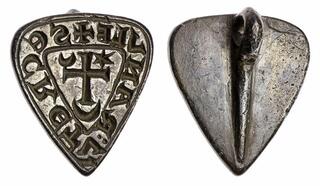| Spink > Auction 24004 | Auction date: 4 April 2024 |
| Lot number: 65 Price realized: 4,000 GBP (Approx. 5,027 USD / 4,670 EUR) Note: Prices do not include buyer's fees. | Show similar lots on CoinArchives Find similar lots in upcoming auctions on |
| Lot description: A Private Silver Seal Matrix to a Knight's Templar (12th-13th Century), + SECRETV : RANVLF in engraved, reversed Lombardic lettering, legend set about an engraved design of smaller shield with Templar cross pattée in the centre, crescent moon at the top, six pointed star to the right, larger crescent moon below, rev. flat with raised rib running down the centre, small circular pierced lug projecting, to act as a handle, 5.48g, length: 21.6mm, width: 19.7mm, thickness: 7.00mm (PAS WILT-7C7D69 this seal; cf. PAS 2019 T664 (SF-1BE964) from South Norfolk and 2009 T698 (ESS-BC8BB7) from Colchester, Essex), a few minor marks, otherwise residual gilding, nicely toned about extremely fine, very rare and of great historic interest. Provenance, Found at Heytesbury, Wiltshire, 26 April 2022, ~ Recorded with the Portable Antiquities Scheme, ref. WILT-7C7D69 ~, ~ ~ Disclaimed by the British Museum (ref. BM 2022 T446) ~, , The inscription means '+ The secret seal (or privy seal) of Ranulf' , , Several candidates are in contention for the identity of Ranulf, narrowed down by the find spot. It is evident from the outset that this was a private seal, removed from any occupation or title Ranulph held, with the symbolism of the crucifix, star and crescent moon associated with the Knight's Templar, the latter an allegory for their crusades against the Moslems. During the reign of William Rufus (1087-1100) and Henry Beauclerc (1100-1135), Bishop of Durham, Ranulf Flambard, was witness to the grant of the Parish of Heytesbury and others, to hold them as Canon of Salisbury from 1101. Flambard would gain notoriety as the earliest document prisoner of the Tower of London, and also the first to escape! , , Based on the dating for the seal, and popularisation of crusading under Richard the Lionheart (1189-1199), Flambard is an unlikely candidate for the seal, much as his ability to possess personal and private seals for his various positions is conceivable. , , Another, and far more likely contender, is the 6th Earl of Chester, Ranulf de Blondeville. He was a powerful aristocrat who spent his lifetime at war on the side of the crown, both at home and on crusade. At the early age of eleven, de Blondeville inherited the earldom of Chester and seven years later was knighted, he would come to be somewhat of a 'medieval superstar' and has been described as "almost the last relic of the great feudal aristocracy of the Conquest" (William Stubbs). , , That same year Ranulf married Duchess Constance of Brittany, the widow of King Henry II's son Geoffrey of Brittany, which gave him control of the Earldom of Richmond, however their match was not a successful one and they soon separated. Subsequently, in 1200, he then married Clemence Fougères, thus cementing his power in Normandy. , , Ranulf spent most of King John's reign in France, and his continued loyalty to the crown heralded continual favour and patronage, however suspicion was never far from the King's mind. There had been rumours of dealings with the rebellious Welsh (Ranulf's homeland) and as a result, his estates were temporarily confiscated, convincing Ranulf to show loyalty in the future. , , He fought in John's Welsh wars of 1209-1212, securing the lands that border the Welsh kingdoms and as a result was a witness for the King at the signing of the Magna Carta in 1215, a momentous honour. He had also spent time with John at Poitou in 1214, during his French Campaign. He gradually accumulated titles including Lord of the County of Lancashire, High Sheriff of both Staffordshire and Shropshire, and Earl of Lincoln in recognition of his extensive support in 1217 by King Henry III. , , Ranulf de Blondeville is thought to have spent time with the Knight's Templar in London, around this time (who had also been supportive of the crown), eventually vowing to join them on the Fifth Crusade. They left for Genoa in 1218 and then went onto to Egypt, at the time, the Islamic capital of the region. De Blondeville held a position of high status during the Crusades and is documented to have been a vocal advocate for a peace deal offered by the Sultan during the Battle of Damietta, in which he offered up Bethlehem, Nazareth, Jerusalem, central Palestine and Galilee. However, nothing came of this and the port city was ultimately taken by the Crusaders. With the city secured, in 1220 Ranulf and other earls headed for home leaving their continuing quest in the hands of the Templars., Estimate: £3000 - £4000 |  |



